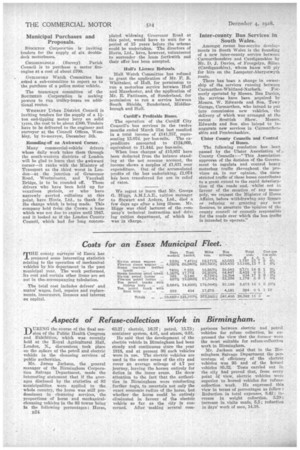Aspects of Refuse-collection Work in Birmingham.
Page 8

If you've noticed an error in this article please click here to report it so we can fix it.
DURING the course of the final session of the Public Health Congress and Exhibition, which was recently held at the Royal .Agricultural Hall, London, N., discussions took place on the sphere of the petrol and electric vehicle in the cleansing services of Public authorities.
Mr. James Jackson, the general manager of the Birmingham Corporation Salvage Department, made the interesting statement that if the averages disclosed by the statistics of 93 municipalities were applied to the whole country, the horse was still predominant in cleansing services, the proportions of horse and mechanicalcleansing vehicles in the 93 towns being In the following percentages : Horse,
B24
63.27; electric, 16.37; petrol, 15.73; container system, 4.01, aud steam, 0.61.
He said that the development of the electric vehicle in Birmingham had been steady and continuous since the year 1918, and at present 86 such vehicles were in use. The electric vehicles are used in the outer areas of the city and cover an average mileage of 4.7 per journey, leaving the horses entirely for duties in the inner areas. He drew attention to the fact that the authorities in Birmingham were conducting further tekts, to ascertain not only the exact economic radius of the horse, but whether the horse could be entirely eliminated in favour of the electric vehicle so far as the city is concerned. After -making several corn parieons between electric and petrol vehicles for refuse collection, he expressed the view that the former were the most suitable for refuse,collection work in Birmingham.
Mr. Jackson said that in the Birmingham Salvage Department the percentage of efficiency of the electric vehicles was 93 and of the horsed. vehicles 85.32. Tests carried out in the city had proved that, from every point 6f view, electric vehicles were superior to horsed vehicles for refusecollection work. He expressed this view in terms of percentages as follow: Reduction in total expenses, 8.43 ; increase in weight collection, 3.29; increase in visits made, 5.5; reduction in days' work Of men, 14.38.






























